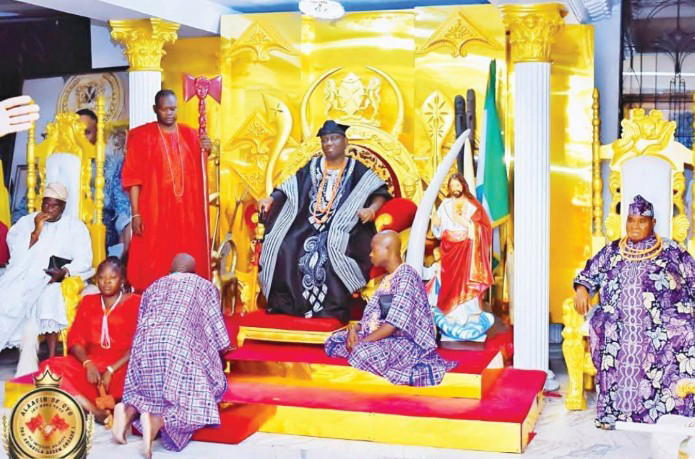By Laolu Elijah, IBADAN
IN the olden days, the Alaafin of Oyo was regarded as a semi-god — often described as the one next to the Almighty.
Beyond his own domains, his fame and authority extended across cities and towns, especially throughout Yorubaland. The mere mention of his title could send shivers down the spines of his subjects.
Such was the level of reverence he commanded after subduing other kingdoms across the region. He reigned as a supreme monarch, and the army under his empire was both powerful and feared.
Though his influence and power have diminished considerably over time, traces of that reverence still remain today. His subjects continue to view him as a figure of supreme authority.
Oyo’s rich cultural heritage
During the reign of Oba Lamidi Adeyemi, for instance, there was a day he went out on foot, accompanied by a large retinue of aides.
As he passed by, men and women rushed out of their homes to pay homage — offering she-goats, farm produce, and other gifts to His Majesty.
A visit to his palace in Oyo Town further underscores the deep importance this revered monarch attaches to tradition.
Every visitor to the palace is held spellbound by the rich display of culture. Statues of deities are strategically positioned, and the entire palace environment is a sight to behold — majestic, historic, and full of meaning.
Two things happen before Alaafin sits
The reverence and influence associated with this sacred stool are also reflected in the seating tradition. Before the Alaafin takes his throne, two things must happen: first, a loyal and trusted aide must sit on the seat before the monarch himself does; second, his attendants usually shield him with their flowing agbada, preventing the public from seeing him as he takes his seat.
Who sits on Alaafin’s seat?
Given the importance attached to this powerful monarch and the stool, it then becomes a puzzle to see a mere mortal sitting on the seat of his imperial Majesty before he sits down.
A very close aide to the monarch, who is not authorised to speak, told Vanguard that: “It is a form of security. All aides of the Alaafin who go out with the Alaafin check where Kabiyesi will sit just like the Depatment of State Security officials will examine the seat of their principal.”
Vanguard findings reveal that someone, who usually occupies the seat before the monarch sits, is a very loyal and trusted aide called Otun Efa.
This individual, according to a source, is well traditionally fortified with charms. He sits on the seat especially when the king moves out of the palace to attend a function outside. Except on few instances, no one else sits with Alaafin on the same seat.
The aide, Otun Efa, will sit after chanting all forms of incantations and doing some other spiritual cleansing.
Another person saddled with the responsibility in the old Oyo Empire was the leader of all women in the palace known as Iyamode.
She was a custodian of powerful traditions. In fact, she is said to be “the only person before whom the Alaafin may kneel.” Iyamode performs purification rites, guards the king’s spiritual safety, and serves as an intermediary between the palace deities and the monarch. Before the Alaafin sits, she or another designated palace official — briefly occupies the seat to fulfill a sacred protocol believed to neutralize unseen forces.
Origin of this tradition
Vanguard gathered that the origin of this tradition lies in the political and religious structure of the old Oyo Empire, which, between the 16th and 18th centuries, was one of the most organised African states.
The Alaafin was both ruler and high priest, but his powers were restrained by a council of chiefs known as the Oyo Mesi and other palace officers such as the Ilari.
In that system, even the king’s actions were subject to spiritual laws. Before sitting, eating, or speaking, there were rituals that acknowledged the presence of the gods and the ancestors.
Apart from the seating tradition, it was reliably gathered that in the olden days, the food and water for the king must be tasted usually by the person who prepared it. After sometime, if no harm happened to the cook, the monarch would then settle to eat.
So, the seating tradition is seen as a sign of respect and a demonstration of the unique and intimate relationship between the king and the Otun Efa, who is one of the most trusted royal household members.
In addition, the action depicts a traditional security precaution.
The primary purpose is to ensure the seat is safe and to defuse or ward off any physical or spiritual harm (such as poison or charms) that might have been planted on the chair to attack the monarch.
Seating tradition unique in Yorubaland
In other Yoruba towns and cities, it is considered the height of disrespect for anyone to sit on the king’s throne.
Instead, a guard is positioned to closely watch the seat. In some cases, the king himself is already fortified during enthronement, so no other power can harm him. It’s either he sees a strange sign warning him not to sit or he places his hand on the seat before he sits down.
But in Oyo town, apart from protecting the king from harm, it is now a unique and strict part of the Oyo Kingdom’s royal protocol, distinct from other Yoruba traditions, that emphasises the sacredness and vulnerability of the king’s person and the need for constant vigilance by his attendants.
Dr Funso Olatunde, a cultural anthropologist, said: “In Oyo, the king is the embodiment of the people’s covenant with their gods. The act of someone sitting first is like a signature that authenticates that covenant.”
Exceptions to the seating tradition
However, there are few exceptions to this tradition. In Oyo Palace where no one enters the king’s palace without clearance, the seat of Alaafin is well protected.
Vanguard correspondent was with Oba Lamidi Adeyemi before he joined his ancestors on April 22, 2022, and the monarch sat down without anyone sitting on the seat first.
The tradition may be impossible to observe at some events. Recently, the Alaafin of Oyo, Oba Abimbola Owoade attended the 91st birthday of Esama of Benin, Dr Gabriel Igbinedion. The monarch sat in the middle of other dignitaries at the front row.
Though tongues wagged on this, one of the royal family members in Oyo, Lashely Ladigbolu, succinctly explained this on his Facebook page saying: “Alaafin is honoured to sit in the main chair of the Esama of Benin in the Palace, Alaafin is honoured to sit in the same first line of the seats with the 91 year-old celebrant and his family in the church as you can see in the picture. Yes, there is no need for blowing unnecessarily out of proportion the ushering of Alaafin to give space for the fragile old man in his church. All protocols observed, not disrespectful however, Alaafin is not interested in petty matters.”
Other people see the tradition as a reflection of the Yoruba worldview of character and humility. They believe no matter how powerful the Alaafin is, he must show reverence to unseen forces and to the offices that sustain his throne. The act of waiting for another to sit first dramatizes this humility.
As strange as the seating tradition to several people, Oyo Town continues to observe it. It’s a form of check and balance to remind the king that his activities and character can still be checked in spite of his awesome power and influence.
The post Ancient tradition behind Alaafin’s throne: Trusted aide ‘tests’ seat appeared first on Vanguard News.

